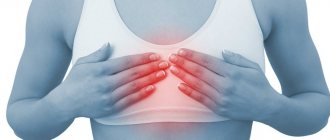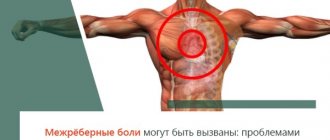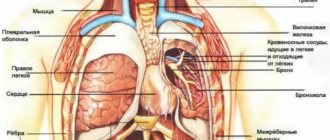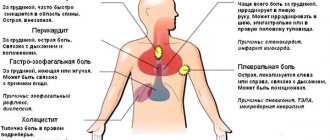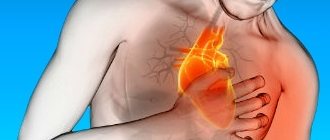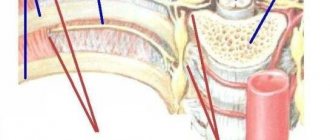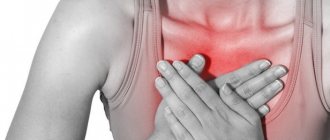Causes of pain in the lungs
Such concepts as lung pain or pain in the lungs do not exist from a medical point of view, since it is a paired organ and does not have nerves that could perceive pain.
But there are certain symptoms that, together with shortness of breath, cough and localized pain, will indicate certain diseases that do not always affect the lungs. Very often, pain in the lungs is accompanied by shortness of breath and cough . There are areas in the lungs where pain may occur - these are the trachea, pleura or bronchi.
For a successful diagnosis, the strength and nature of pain in the lungs, its localization, connection with shortness of breath and cough, and the effect of taking certain medications are of great importance. If severe pain is felt in the lungs, then most likely there is one of the acute diseases. Quite often, such pain occurs against the background of heavy breathing and intensifies with breathing, which indicates pleural pain.
If pain in the lungs is felt in the area behind the sternum and is pronounced, and even intensifies when coughing, then these are the first signs of tracheitis. An exciting symptom is chest pain, which is accompanied by difficulty breathing and is difficult to treat. Quite often, patients complain of pain in the lungs, which radiates to other organs: pain behind the sternum, as well as in the area of the heart, between the shoulder blades, or radiating to the left limb - this is a sign of possible coronary insufficiency.
Causes of back pain when inhaling. Treatment and prevention.
Pain occurs for a number of different reasons that we may never have heard of. Many people, when experiencing back pain, do not understand what to do. After reading this article, you will understand the causes of pain and learn about treatment and prevention.
Causes of back pain
Doctors describe quite a lot of different reasons for these sensations, but the main ones will be discussed. But first we need to understand how and with what we inhale and exhale. First of all, when you inhale, the nerve fibers and muscles contract, and then the diaphragm lowers. Thus, the lungs take in air.
Painful sensations in the back can appear not only due to diseases of the spinal region, but also due to various diseases of the internal organs of a person. Doctors say that when the lungs are damaged, the volume of the abdominal cavity decreases, which results in back pain.
Remember that only timely back treatment
and other organs, will help prevent pain and subsequent consequences. It is impossible to determine the causes of pain on your own, so at the first manifestations you should immediately consult a doctor for advice. To begin with, the doctor will order an x-ray; if no cause is found, you will continue the examination. After the X-ray, you will undergo an ECG, abdominal MRI and fluorography.
spinal diseases
When we inhale, our chest expands and promotes the expansion of the ribs, which is why back pain may occur. Let's look at several pathologies of the spine. Frequent diseases in women and men:
1. Arthritis
This inflammatory disease manifests itself both when sighing and at complete rest. Arthritis pain is divided into: intense and aching. Arthritis can also be accompanied by high fever and weakness throughout the body.
2. Hernia
lumbar intervertebral hernia
department leads to compression of the nerve roots. This disease is not so often associated with pain when breathing, but despite this, it is with a deep sigh that painful sensations in the hernia can appear. Numbness of the extremities and a tingling sensation are also possible.
3. Osteochondrosis
It is the most common disease in men and women. Any inhalation or exhalation leads to compression of the nerve roots, which gives pain in the spinal region.
4. Sciatica
In case of untimely treatment, inflammatory processes appear in pathologies. Therefore, both permanent and temporary pain in the chest and back may appear.
Muscle pathologies in the spinal region
Another fairly popular cause of back pain when breathing is pinched nerve endings. Painful sensations can be either periodic or constant. Often accompanied by sharp and burning pain, and can radiate to the sternum area.
In general, inflammatory diseases inside the body provoke the appearance of unpleasant sensations that bring discomfort in the life of every person.
Referred pain
Every person has had back pain at least once. Most often the sensations are sharp and unbearable. But the problem is that it can hurt in the lower part of the spine, and the cause of the disease lies in the internal organs. For example, you have an inflammatory process in your kidneys, and pain appears in your back. This phenomenon is called referred pain.
Causes:
- Gastrointestinal diseases (can be reflected from liver pathologies, ulcers, gastritis, etc.);
- Pleurisy (during inflammation, the pleura thickens and rubs against each other, resulting in pain);
- Angina pectoris (heart disease can also be a cause of spinal pain);
- The tumor is malignant (when it appears in the chest, various sensations of burning pain appear). Regular painkillers do not help.
What to do when you first experience pain in the back?
As many people know, this problem brings discomfort to a person’s life. Especially if you need to go to work or stay at home with children. What should you do first to avoid harming yourself later? Don't self-medicate, you can only make things worse. Consult your doctor for advice. He will examine you and prescribe the necessary tests and additional examinations that will correctly indicate the cause of the discomfort.
But what to do if the sensations are very painful, and there is no doctor yet. You need to lie down on a flat, hard surface and lie quietly, inhaling and exhaling slowly. You can drink Analgin to reduce pain, and also use various warming ointments for greater effect. But, not paying attention to the problem, drinking painkillers every day, you are only making your situation worse.
If you do not have any problems with your back or joints, then it is important for you to study ways to reduce the likelihood of the disease or preventive measures. It is necessary to do daily exercises, perform sports activities, be examined by doctors at least once a year, eat right and create conditions for a life without blowing, etc.
To summarize the article, it should be noted that there are a lot of diseases that lead to pain in the back when inhaling and exhaling, and you cannot diagnose and treat yourself.
In various cases, time passes very quickly, and there are situations that are simply impossible for even the most experienced doctors to correct. But despite this, there is now high-quality and effective medicine. Specialists know how to correct and cure even the most complex and neglected situations of people. Contact your doctor and stay healthy! Author: K.M.N., Academician of the Russian Academy of Medical Sciences M.A. Bobyr
Diseases that cause pain in the lungs
Pain in the lungs is most often a manifestation of a certain disease, and ignoring such symptoms means not worrying about your health. People feel pain in different ways: sometimes they cut, sometimes they prick, sometimes they press. The location of the pain is also an important factor. By summing up all the symptoms of pain in the lungs, it is possible to make a correct diagnosis, since there are many diseases in which pain in the lungs is felt.
Diseases in which a person experiences pain in the lungs:
- Pneumonia;
- Bronchitis;
- Acute tracheitis;
- Lobar pneumonia;
- Pleurisy;
- Spontaneous pneumothorax;
- Lungs' cancer;
- Bronchial asthma;
- Pain of bone, joint or muscle origin;
- Heart diseases;
- Pericarditis;
- Pulmonary embolism;
- Aortic diseases;
- Pancreatitis;
- Stomach and duodenal ulcers;
- COPD
Survey
Patients with complaints of difficulty in exhaling most often turn to a pulmonologist or therapist. Expiratory shortness of breath indicates serious disorders in the respiratory system, so a comprehensive laboratory and instrumental examination is necessary. During the diagnosis, the specialist evaluates the morphological features of the trachea, bronchi and lungs, and also examines the functional state of these organs. The most informative are:
- X-ray examination
. To study the features of the anatomical structures of the chest cavity, a standard chest x-ray is performed in two projections - frontal and lateral. The method helps to detect deformations of the bronchi and trachea, signs of sclerosis and emphysema. For better visualization of the respiratory tract and neighboring organs, it is prescribed. - Bronchoscopy
. Endoscopic examination is aimed at studying the structure of the mucous membrane, identifying pathologically altered areas of tissue and cicatricial stenoses. According to indications, the method is supplemented with forceps biopsy and bronchoalveolar lavage, followed by microscopic and bacteriological analysis of rinsing water. - Spirometry
. The nature of breathing difficulty can be established by studying the main indicators - forced expiratory volume in the first second, functional vital capacity of the lungs, Tiffno index. For differential diagnosis between bronchial asthma and other obstructive pulmonary diseases, a bronchodilator test is recommended. - Lab tests
. The degree of respiratory failure is determined according to blood tests - the level of hemoglobin oxygen saturation and the concentration of carbon dioxide are determined. In the presence of a general infectious syndrome, a bacteriological blood test is indicated. To clarify the type of pathogen, serological reactions are carried out (RIF, ELISA, PCR).
To determine the etiological factor of bronchial obstruction in the remission phase, allergy tests are prescribed. If a congenital disease of the respiratory system is suspected, consultation with other specialists is required.
Spirometry
Symptomatic therapy
Difficulty in exhaling often indicates organic diseases of the respiratory system, so qualified medical care is necessary. If the disorder occurs for the first time and is severe, you should urgently call an ambulance. Before doctors arrive, it is important to provide the patient with peace and sufficient flow of fresh air, place him in a semi-lying position, and limit contact with possible allergens. To reduce emotional stress, you can offer mild herbal-based sedatives.
If an attack occurs in a patient with an established diagnosis of bronchial asthma, you should immediately take previously prescribed bronchodilators in the form of an aerosol (beta-adrenergic agonists, anticholinergics, myotropic antispasmodics). For inflammatory diseases, expectorants can be used, and for allergic conditions, antihistamines can be used. In other cases, special medications can be used only after examination by a doctor, taking into account his recommendations.
MBST therapy
MBST therapy is a therapeutically advanced nuclear magnetic resonance technology used in the treatment of diseases and injuries of the musculoskeletal system. Nuclear magnetic resonance technology is used to treat chest pain. The purpose of using MBST therapy is to initiate recovery processes. After the procedure, pain and inflammation in the affected area disappear.
You can sign up for the MBST therapy procedure in Moscow for the treatment of a thoracic hernia at ArthroMedCenter.
Pain in the left side of the chest can develop for various reasons. Diseases of various organs (lungs, heart, spine) can provoke the appearance of such a sign. If you notice chest pain on the left, you should definitely consult a doctor and undergo an examination.
Sharp nature of the pain syndrome
The sharp nature of the pain may indicate perforation of the stomach or perforation of the upper parts of the small intestine. This type of pain is a reason to immediately call an ambulance.
Sharp pain also indicates a rupture of the splenic capsule. If the pain becomes girdling, the doctor may suspect an attack of acute pancreatitis. In this case, the discomfort is not associated with changes in body position, sudden movements or coughing.
Sharp pain is a sign of perforation of the stomach walls
Pain under the left rib in front
Most often, such localization indicates diseases of the stomach or spleen. If the pain is dull, aching and periodic in nature, and also occurs regardless of meals, then most likely we are talking about splenomegaly or splenitis.
Additionally, pain in the front can often indicate a diaphragmatic hernia or abscess. In this case, the pain is sharp and acute with increasing intensity.
An experienced doctor conducts a differential analysis and necessarily excludes colitis. If the inflammation is associated with the upper loops of the intestine, then pain may occur in the area of the left hypochondrium. Also, pain in the left side can be caused by myositis, cholecystitis and myocardial infarction.
If the pain becomes girdling, the doctor may suspect an attack of pancreatitis.
Pain under the left rib behind
Such localization of pain may lead the doctor to think about the presence of kidney disease. To confirm the diagnosis, a general blood test and ultrasound examination are prescribed. Sometimes pain under the ribs at the back indicates the presence of lumbar or thoracic osteochondrosis. X-rays, CT scans, and blood tests may be needed to make a diagnosis.
Pain in the left intestine
Other reasons can cause such pain, namely:
- pericarditis;
- pneumothorax;
- pleurisy;
- renal colic;
- acute pancreatitis;
- myocardial infarction.
